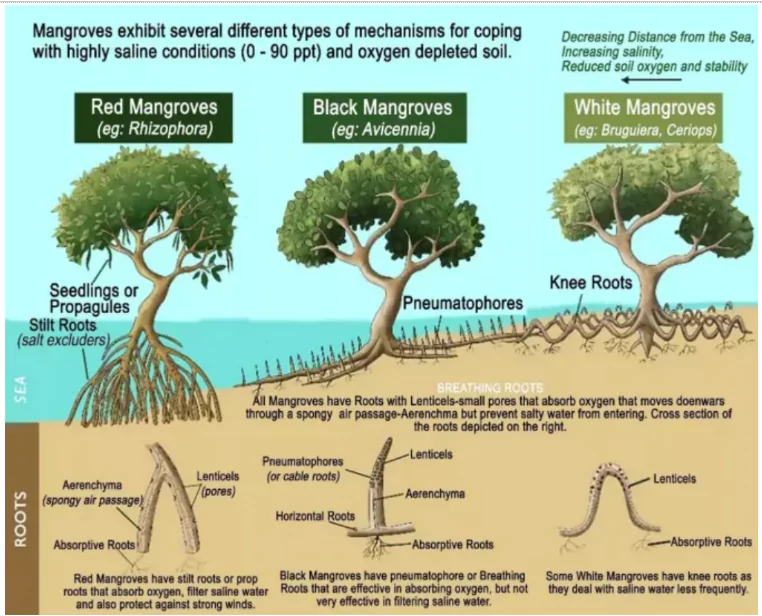Mangrove Sites in India, coastal plant growth in tropical regions, play a vital role in safeguarding coastlines. India is home to 3% of South Asia's mangrove cover.

Mangroves are a type of coastal plant growth found along sheltered tropical and subtropical coastlines. These shrubs and trees thrive in areas with high water levels during spring tides and demonstrate a remarkable ability to withstand saline water.
India is home to about 3 percent of the total mangrove cover in South Asia, with the Sundarbans in West Bengal and Bhitarkanika mangroves in Odisha being the richest in diversity.
The largest mangrove forest in the world is the Sundarbans. The Sundarbans are located in the vast delta formed by the confluence of the Ganges, Brahmaputra, and Meghna Rivers on the Bay of Bengal. It covers a total area of approximately 10,000 square kilometers, making it the world’s largest single block of tidal, halophytic (salt-tolerant) mangrove forest.
One of the world’s largest mangrove forests, spanning 140,000 hectares, is located on the Bay of Bengal’s Ganges, Brahmaputra, and Meghna river delta. It is close to the 1987-listed Sundarbans World Heritage site in India. The location provides a superb illustration of continuous biological processes and is crossed by a complicated system of mudflats, tidal canals, and small islands of salt-tolerant mangrove forests. The region is renowned for its diverse biodiversity, which includes 260 bird species, the Bengal tiger, and other species in danger like the Indian python and the river’s crocodile.
They have the ability to survive in waterlogged and anoxic soil, and to tolerate brackish water with the adaptations.

As per Global Forest Resource Assessment, 2020 (FRA 2020), world over, 113 countries have Mangrove forests covering an estimated 14.79 million hectares. The largest Mangrove area is reported in Asia (5.55 mh), followed by Africa (3.24 mh), North and Central America (2.57 mh) and South America (2.13 mh).

Mangroves are found in coastal areas featured by tidal waters, brackish water, and saline/salty soils. India is home to diverse mangrove habitats, ranging from the Sundarbans in the east to the Gulf of Kutch in the west. These mangrove forests provide crucial ecological services and support various species of plants and anima and aquatic species, making them Important ecosystems for coastal communities and biodiversity conservation efforts.
| State | Mangrove Sites | Area Covered (sq km) |
| West Bengal | Sundarbans | 4,260 |
| Odisha | Bhitarkanika | 672 |
| Andhra Pradesh | Krishna Wildlife Sanctuary, Godavari Wildlife Sanctuary | 303 |
| Gujarat | Gulf of Kutch, Kori Creek, Jamnagar | 1,139 |
| Maharashtra | Ratnagiri | 158 |
| Goa | Cumbarjua Canal | 2 |
| Tamil Nadu | Pichavaram, Muthupet | 304 |
| Karnataka | Aghanashini, Sharavathi Delta | 170 |
| Kerala | Vembanad, Kannur | 248 |
| Andaman & Nicobar | North, Middle, and South Andaman, Ritchie’s Archipelago | 8,249 |
| Mizoram | Saiha, Lengteng Wildlife Sanctuary | 10 |

According to the State of Forest Report 2021 in India, the assessment offers distinctive Facts about the stats and data of mangrove cover throughout the country.

To safeguard India’s mangrove forests, various national and international initiatives have been implemented. Important species of Mangrove ecosystems in India include Avicennia officinalis, Rhizophora mucronata, Sonneratia alba, Avicennia alba, Bruguiera cylindrica, Heritiera littoralis, Phoenix paludosa, Morinda citrifolia & Ceriops tagal.
Mangroves in India serve as Important coastal ecosystems, Serving habitat for diverse flora and fauna and acting as natural defense against erosion and storm surges. These mangrove forests have a crucial role in carbon sequestration, helping mitigate the effects of climate change, while also supporting local livelihoods through fisheries and ecotourism.
Check Out UPSC CSE Books
Visit PW Store
| Must Read | |
| NCERT Notes For UPSC | UPSC Daily Current Affairs |
| UPSC Blogs | UPSC Daily Editorials |
| Daily Current Affairs Quiz | Daily Main Answer Writing |
| UPSC Mains Previous Year Papers | UPSC Test Series |
According to the Ministry of Environment, Forests, and Climate Change (MoEF&CC) has published a list of 38 mangrove sites in India as of 2021. (Source: Annual Report MoEF&CC 2020-21). Maharashtra has the greatest number of mangrove sites in a state (10), followed by Orissa (7 sites)
Mangroves are coastal trees that thrive in tropical and subtropical regions, with unique Features to live in saline water and tidal situations.
The State of Forest Report 2021 indicates that India's mangrove cover is 4,992 square kilometres, showing a substantial increase in comparison to 2019.
Mangroves play a crucial and important function in defending coastlines, providing breeding grounds for marine existence, and contributing to biodiversity.
Odisha leads with a growth of 8 sq.Km, followed by Maharashtra with 4 square km, and Karnataka with an increased cowl of 3 square km in mangrove cover..
Mangrove forests face threats from pesticide use, industrial activities, sewage outflow, saltpans, aquaculture, and land conversion alongside the Western Coast.
<div class="new-fform">
</div>
